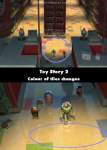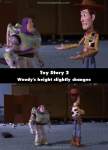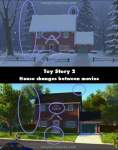
Continuity mistake: When the Toys enter Al's Toy Barn looking for Woody, the colour of the tiles right after the cashiers don't match between the aerial and close-up angles.

Continuity mistake: Woody's height slightly changes in the scene where Buzz tries to convince him to return with them. You can notice that from the scene where Woody starts to explain why he doesn't want to come back, and in the one where he turns away and keeps his arms folded.
Continuity mistake: In the baggage area when Woody fights with Pete, his arm is torn (an injury which had previously rendered it useless). However, in the next scene going to rescue Jessie, he is using the arm freely and there is no sign of a tear or fix. There is then reference (and visible signs) later in the film that the arm has been fixed.

Continuity mistake: With upgrades in animation the house Andy's family moved to at the end of the first film has undergone some slight changes. The house is still the same general shape, red in color and with the doors and windows in the same place. But the Toy Story 2 version gained an arch above the front door. Also, in the first movie the house was in front of some large pine trees, there was a straight path from the door to the street, and there was a wooden fence in the front yard. In Toy Story 2 the fence is gone, the path from the front door bends toward the driveway, and the pine trees behind the house are replaced by generic types of trees. The house also is much more detailed (as is most of the animation compared to the first movie), allowing the shading of the brick pattern to come in. (00:10:25)
Continuity mistake: At the beginning of the movie, Buster knocks over the Troikas (the toys that fit inside each other), but they vanish a couple of shots later. We can see that they aren't behind Buster when he sniffs the bedroom and heads near the Potato Heads.






Answer: As we learn later, Stinky Pete has his own agenda. He's seizing on the fact that Woody was being sold as a way to convince Woody to go to the museum.